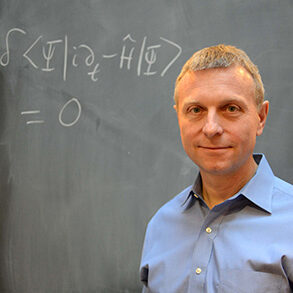Donor Profile: Mark Mueller
Mueller makes a lead gift to endow a fellowship in honor of his undergraduate thesis advisor, Professor of Physics Emeritus Arthur Kerman.
by Erin McGrath // MIT Physics Annual 2011

Mark Mueller ’78 studied theoretical physics as an undergraduate with Arthur Kerman in the 1970s. After a long hiatus and career in the financial services industry, Mark has reconnected with Arthur, MIT, and the Center for Theoretical Physics1. He shares his journey from physics to finance and back, and why it was important to make a gift in Arthur’s name.
“I knew I was a physicist at a young age. I loved trying to understand things around me and it dawned on me that they could be described by mathematics. I fell in love with MIT when I visited as a senior in high school. I remember attending a class on electrodynamics where [Professor of Physics Emeritus] Earle Lomon was the instructor; my office is now next to his in the Center for Theoretical Physics1. Even though Caltech had Feynman, I just felt MIT was where I belonged. During my junior year, I started working with Arthur and in my senior year I began doing research with him that led to my undergraduate thesis. Arthur has great taste in problems and I’m still really proud of the work I did with him.”
After MIT, Mark attended Stanford University (Ph.D. ’84, Physics) for graduate school, and went on to do postdocs at the Institute for Advanced Study, the University of Pennsylvania, and Harvard. He segued into finance after auditing some classes at the Harvard Business School. This was also the time when the Superconducting Super Collider was cancelled, and Mark started interviewing on Wall Street. He joined Morgan Stanley and became a quant2, then worked at Goldman Sachs and later at Grantham Mayo Van Otterloo and Co. (GMO) in Boston. Mark really liked the culture at GMO, and it was a rewarding experience, during which he spent 12 years and became a partner. While at GMO, Mark co-founded an algorithmic trading group that was involved in high-frequency trading. The new trading division was very successful in running strategies with high return-to-risk ratios. At this point, as Mark says, “I hit my number (everyone in finance has their number),” and he knew it was time to retire from finance and return to physics.
There is nothing that gives me more pleasure than working with students and it has been a joy to work with Mark again after all these years.
Professor of Physics Emeritus Arthur Kerman
Mark first reconnected as a donor to the Physics Department when he joined the Patrons of Physics Fellows Society. He enjoyed getting to know the student who was the recipient of his graduate fellowship and continues to cultivate that relationship to this day. “Graduate students are fearless; I know, I was one. They think they can solve these intense problems and attack them head-on, and it gives me great joy to bounce ideas back and forth with them.” Mark joined the Society because he’d heard that graduate fellowship support was the top priority for the Department. His involvement with the department deepened as he felt he was treated not just as a donor, but as a member of the physics community.
Even though Mark had retired from finance he still felt the pull of physics and wondered how he could find his way back in. He continued with his physics research interests and became a visiting scientist in MIT’s Center for Theoretical Physics (CTP)1. At the CTP1, Mark was pleased to find that his former advisor Arthur Kerman was still involved in research, as well as scientific consulting. For Mark, it was a delight to come back and work with his greatest mentor in physics and return to the types of problems he was working on with Arthur so many years ago. Mark also expressed his appreciation of the CTP1, a community that he believes needs to be sustained. He has a great admiration for the faculty members in the Physics Department and feels they have a deep respect for the students that is clearly apparent. Mark says, “Faculty members are mentors, but they act like colleagues, and as a student you don’t feel marginalized or dismissed. The Department fosters creativity and innovation and is open to good ideas from the top level to the students; it’s a great example of what makes MIT a meritocracy. For me, this has been more evident at MIT than any other place. For that reason, I wanted to give back to MIT physics and create a permanent endowed fellowship in Arthur’s name.”
1. On May 28, 2025, the MIT Center for Theoretical Physics (CTP) was renamed the MIT Center for Theoretical Physics — a Leinweber Institute (CTP – LI).
2. A person working in financial markets, in roles such as a researcher, trader, or portfolio manager, who uses quantitative methods and models with the goals of making profits and managing risks. Quants come from areas such as engineering, computer science, operations research, mathematics, and physics, and apply their skills to quantitative problems in a wide variety of global financial markets. The now ubiquitous use of computers and electronic trading, as well as the use and abuse of complex derivative securities, has made quantitative literacy an indispensable part of modern finance. [M.M.]